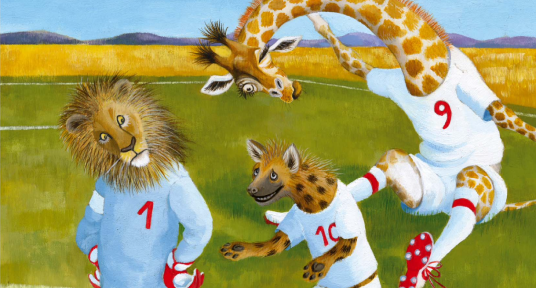Tutorial 3
Expanding knowledge
Reading sessions are ideally suited to give targeted support to children’s linguistic, cognitive and emotional development.

Supporting language(s)
Interactive reading strengthens language development by discussing content and explaining new words and signs.
Be responsive to the children
Let them decide what you discuss, and how long you spend on each page. This is particularly effective in one-to-one work.
Answer all questions
Children have many questions about the book’s content. Answer them yourself, or encourage other children to answer, to stimulate conversation.
Encourage the children in their linguistic endeavours
Be positive and sensitive in discussions. Tolerance of mistakes, and attentive and non-judgemental communication are important.
Affirm and repeat the children’s statements, so that they feel understood.

Child:
“Did the hyena kick the ball into the waterhole?”

Teacher:
“That’s right. The hyena kicked the ball into the waterhole.”

Expand the children’s sentences, so that they can think further ahead in the story.

Child:
“Did the hyena kick the ball into the waterhole?”

Teacher:
“That’s right. The hyena kicked the ball into the waterhole, and everyone is wondering how to get it back.”
If a child’s statement is a little imprecise, or incorrect, repeat it correctly. This will enable the child to learn without feeling bad.

Child:
“Did the hyena throw the ball into the waterhole?”

Teacher:
“Yes, the hyena kicked the ball into the waterhole.”
Repeat and emphasise unfamiliar signs or words in the book, for example, the word or sign for ‘hyena’.

Teacher:
“This is a hyena. A hyena has brown spotted fur. A hyena has lots of sharp teeth.”
Simplify sentences and signs/words, to make comprehension easier. This will help children follow the story more easily.

Text:
“The hyena giggles sheepishly.”

Teacher:
“The hyena laughs. She’s feeling a bit unsure.”

Explain difficult passages in your own signs/words.

Teacher:
“At the beginning, there were ten players in the football team. Now there are eleven, because the crocodile has joined them.”
Encourage the children to say or sign the sentences with you.

“The lion is yelling ‘FOUL!!!’ really loudly. Let’s sign/shout together.”

Use a range of synonyms, to demonstrate the variety in a language.
Example, spoken:

Teacher:
“All the animals look at the goal. All the animals stare at the goal.”

Expanding understanding
Expand children’s knowledge of the world
Include the children, to stimulate their knowledge.

“Can you tell me which animals live in the forest?”
This will help them connect new discoveries from the book to things they already know.
Encourage them to draw parallels with their own lives:

“Are you allowed to play with your parents’ phones? What’s that like for you?”
Support recall
Create lists while you are reading:

“There are lots of different animals living in the forest. Which animals have we met so far in the book?”
Strengthening emotional intelligence

Ask the children how the characters feel, and discuss the reasons. This will enable them to learn signs and words important for naming emotions.

Ask them to describe the emotions they see.

Pick out characters and imitate them. Let the children copy.

Take on the perspective of the characters: ask why the characters are acting or thinking as they do, or what they want.
You can find a list of suitable picture books here >


Tasks
Tasks

Having carried out your intensive preparation, film yourself reading aloud. Analyse the video to check how you have applied the strategies for language development.

At your next reading session, concentrate on expanding children’s understanding, or strengthening their emotional intelligence. Use the guidance in this tutorial.
